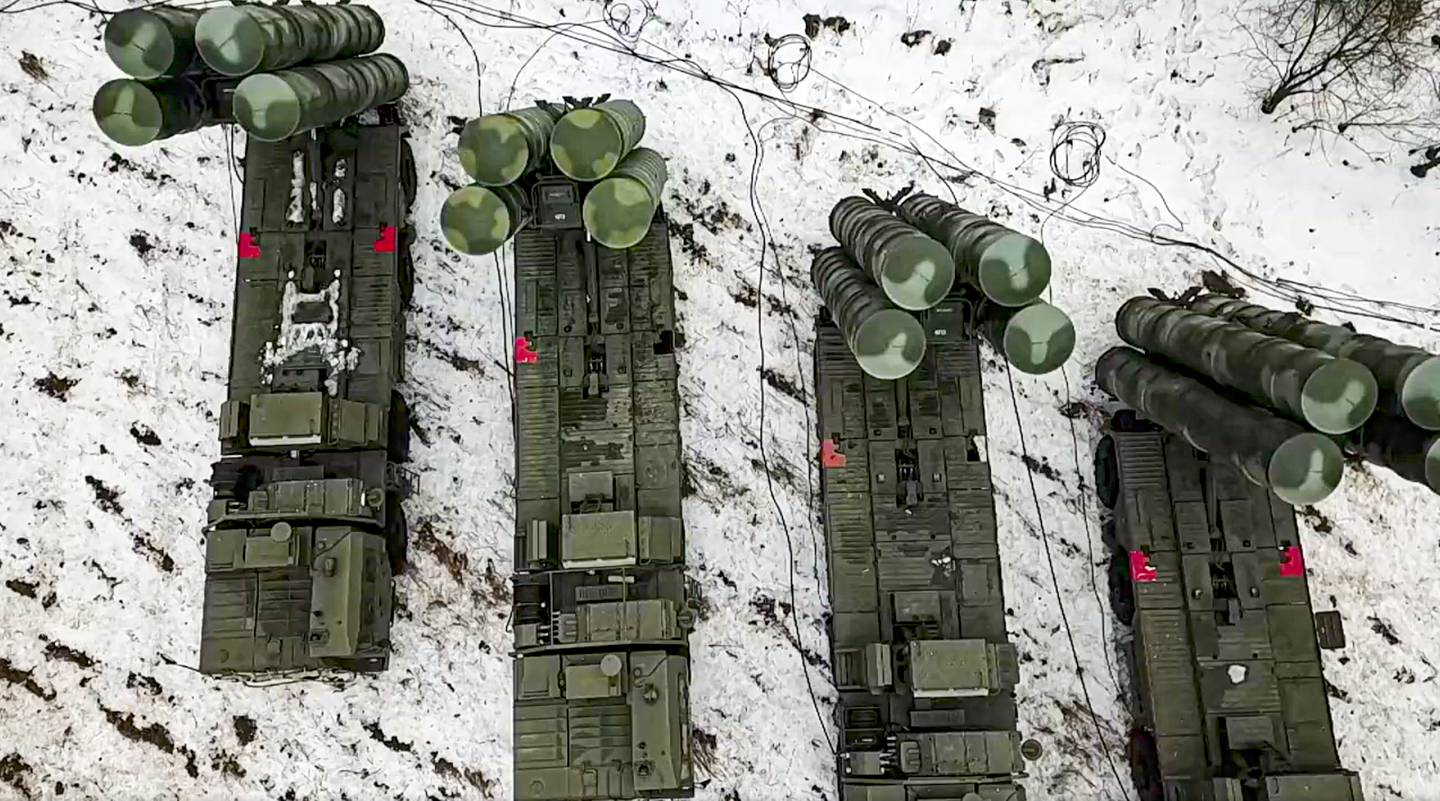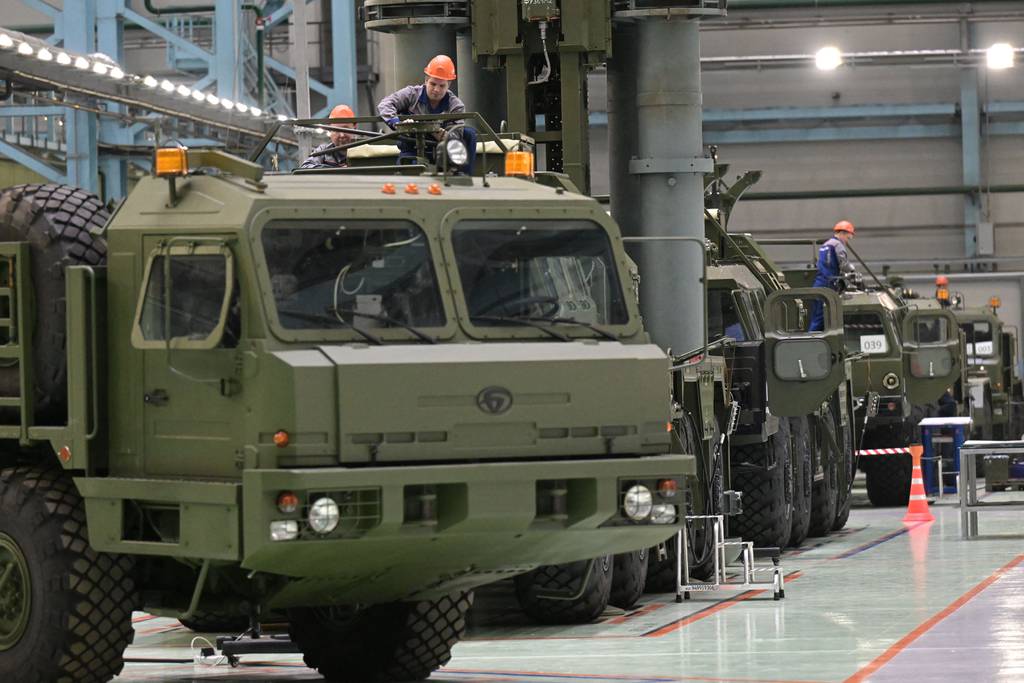MOSCOW — In late August, Russian Defence Minister Sergei Shoigu traveled to a factory of air defense systems manufacturer Almaz-Antey to inspect its artillery production, emphasizing to the company the importance of round-the-clock work, according to state-run news agency Sputnik.
This was Shoigu’s second inspection of an Almaz-Antey property this year, having visited another facility in June that makes anti-aircraft missiles, the government news agency Tass reported.
During the more recent tour, Shoigu and the head of Almaz-Antey emphasized the effectiveness of the S-300, S-350 and S-400 air defense systems amid Russia’s full-scale invasion of Ukraine. However, there was no mention of the more advanced S-500 Prometheus air defense system.
Russia has sought the S-500 as a means of countering hypersonic weapons, and it would be able to reach farther into enemy territory. The weapon is expected to defeat threats at a range of 600 kilometers (373 miles), according to the Center for International and Strategic Studies think tank, whereas the S-300 and S-400 can reach 150 kilometers and 400 kilometers, respectively.
As far back as 2018, President Vladimir Putin called for the mass production of the S-500. However, its manufacturer appears behind.
According to Michael Jerdev, a Russia military expert, international sanctions levied against the country may be negatively impacting work on the air defense system.
“Russia can multiply the production of air defense missiles, primarily missiles of the 48N6 family, as they are technological products with minimal dependence on foreign components,” said Jerdev, referring to the primary missile series for the S-400. “As for the production of anti-aircraft complexes and radars themselves, their production has a long cycle and depends on the supply of foreign electronic components, which obviously does not allow them to be produced around the clock.”
Furthermore, an Almaz-Antey employee said, the company is experiencing “problems with machine tools and a shortage of components.”
“The enterprise’s [production rate] has increased,” the source told Defense News on the condition of anonymity to speak freely, but “there are not enough workers.”
Meet Prometheus
Developing aerospace defense capabilities has been a major component of Russia’s State Armament Program since 2020.
The program is meant to lead to the deployment of 100 battalions, which include 800 launchers made up of S-350, S-400 and S-500 systems. Under the latest iteration of Russia’s State Armament Program, also known as GPV-2027, funds are to go toward the production of the S-500 Prometheus. The previous iteration, GPV-2020, laid out efforts to create, produce and maintain military equipment.
Russia began developing the S-500 in 2010, according to the Center for Strategic and International Studies, which tracks the status of air and missile defense systems. In 2011, Russia unveiled plans for two new plants to produce the S-500; they opened in 2016. According to Russian media, one S-500 system would cost an estimated $700 million to $800 million in 2020, and up to $2.5 billion dollars in 2023.
In 2019, production of the S-500 began for the Aerospace Forces, according to the head of Russian defense conglomerate Rostec, Sergey Chemezov. The Defence Ministry and local company Almaz-Antey signed a contract for the supply of more than 10 S-500s in 2021, with the first delivery expected in 2022, Tass reported during the 2021 MAKS air show.
Also in 2021, the 1st Special Purpose Air and Missile Defense Army, whose primary mission is the defense of Moscow, received its first S-500 system. However, the system arrived in a reduced configuration that did not meet the full requirements of the defense force. Experts who spoke to Defense News specifically cited the lack of exoatmospheric missiles.
“Almaz-Antey and other air defense manufacturers are currently producing products aimed at meeting the needs of a military operation,” Jerdev said. “Neither the S-500 nor the Abakan air defense system have targets in Ukraine — the ballistic missiles — so their production is not a priority.”
Launch capabilities
Available information about the S-500 indicates it can defeat threats at a range of 600 kilometers (373 miles) and an altitude of up to 200 kilometers (124 miles). But Russian media recently reported the S-500′s range is closer to 500 kilometers and can reach an altitude of up to 100 kilometers.
Defense News was unable to independently verify either of the specifications.
According to analysis by the Center for Strategic and International Studies, the S-500 can launch several interceptor missiles, including “the 40N6M for use against aircraft and cruise missiles, and the new 77N6 and 77N6-N1 to counter ballistic missiles or satellites.” The 40N6M has a range of 400 kilometers, while the 77N6 series interceptors can reportedly reach a range of 500-600 kilometers, the think tank found.
“Initially, the S-500 was positioned as a system better than THAAD [the U.S.-made Terminal High Altitude Area Defense system] with the possibility of exoatmospheric interception. At the same time, it had to be more compact than the S-400. However, the S-500 does not turn out to be more compact,” Pavel Luzin, a senior fellow at the Center for European Policy Analysis think tank, told Defense News. “In addition, the 40N6 rocket, which is equipped with the S-500, is already used in the S-400 and is not unique.”

In 2014, reports noted the S-500 was to launch 77N6-H and 77N6-H1 missiles. Since then, the development of the former was confirmed, but the status of the latter, meant to be able to destroy satellites in low Earth orbit and feature a low-yield nuclear warhead, is unclear.
“According to its characteristics, the S-500 seems to be superior to the S-400, but it falls decently short of THAAD — there is no exoatmospheric interception. The dimensions of its 77N6-N anti-missiles are smaller than the PRS-1M/53T6 missiles of the Nudol [anti-satellite] system, [therefore the former’s] interception height is lower,” Luzin said.
According to a Russian colonel who spoke on the condition of anonymity for safety, the second stage of the 77N6-N anti-aircraft missile is identical to the second stage of the 9M82MV missile used by the S-300′s V4 variant. The first stage has aerodynamic controls that maintain efficiency only in the upper stratosphere and lower mesosphere layers, about 50 kilometers above Earth’s surface, the colonel added. If it were to maneuver in low orbit areas, the 77N6-N would require a compact and light third combat stage, but there is no such stage.
Experts interviewed by Defense News doubt the 77N6-N and 77N6-N1 missiles can provide the S-500 with the accuracy required for its mission. These missiles were supposed to be the first Russian missiles with inert warheads, but the domestic industry has been unable to acquire the necessary quality of electronics, Luzin and the colonel each told Defense News.
Furthermore, the minister of industry and trade, Denis Manturov, said in June that the S-500 will be able to intercept hypersonic missiles. However, the S-500 has not undergone testing for this capability, the colonel explained, and it doesn’t appear Russia has target missiles that would mirror the characteristics of a hypersonic weapon.
Plans for an S-550
The State Armament Program is also expected to accomplish by 2027 the creation of the S-550, an anti-missile and anti-space system with improved detection capabilities and a greater range compared to the S-400 and S-500. The Aerospace Forces are to receive the S-550 by 2025.
Putin in November 2021 emphasized the importance of supplying S-550 systems to the military during a meeting with defense and industry officials, according to Shoigu.
That same month, Chemezov, the Rostec chief executive, said the S-550 would feature a longer detection range and improved missile range compared to existing air defense systems.
Experts interviewed by Defense News differed in their assessments of the S-550′s potential capabilities, but did agree the system will complement the capabilities of the S-500, and that its main purpose will either be to defeat hypersonic targets or satellites.
There is currently no evidence Russia has developed the S-550.
Maxim Starchak is a Russia correspondent for Defense News. He previously worked as an editor for the Russian Defence Ministry and as an expert for the NATO Information Office in Moscow. He has covered Russian nuclear and defense issues for the Atlantic Council, the Center for European Policy Analysis, the Royal United Services Institute and more.








